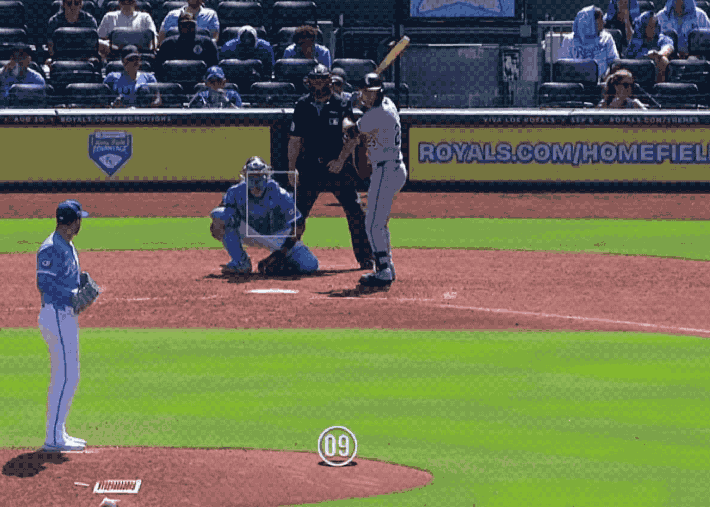The White Sox made Curtis Mead the centerpiece of the three-player return for Adrian Houser last month, on the premise that the 24-year-old former top-100 prospect has yet to receive a proper chance to get untracked at the major league level. Mead would certainly admit that his path to playing time in Tampa, even after he beat out Eloy Jiménez for the final roster spot out of spring, had grown fraught.
"I kind of went into the deadline hoping to come someplace like here," Mead said. "I felt like I was valued in Tampa, but I understood that the third, second and first basemen were all All-Stars this season. I was aware enough that they're awesome players, but I don't think that means that I'm not a good player, too. So I was pretty excited when I got traded here."
Even limited to a .629 OPS in 123 games scattered over three big league seasons, Mead already has the fourth-most career hits (86) for an Australian-born player in MLB history. The collection of players who have navigated his journey is small, but he doesn't want that to double as a prognostication of his ceiling. When asked a question about whether all Australian pro baseball players have a group chat, Mead doesn't reflect on it as another hallmark of his rare baseball origins, but simply confirms "Yeah, there is."
Accordingly, he initially went along with his walk-up song being "Down Under" by Men at Work, before opting for his own selection after a few days with his new team. Mead wants to be more than a novelty act, more than someone known simply for being Australian, and the traces of that desire are evident over his last three years of swing video.
"I kind of tinker a lot with my swings and my moves," Mead said. "I don't think I'm against tinkering, but too much of it is obviously not good. I'm just making the adjustments I see fit along with the guidance of the coaching staff."
Mead agrees with the idea that lying idle has made it easier for him to drift into the headspace of easily finding reasons to make adjustments, so the White Sox's usage plan for him is relevant even before he enters next spring without any minor league options remaining. Seemingly, multiple paths to at-bats are open. He doesn't profess any restrictions within the three infield positions he's appeared at (first, second and third base), and Chris Getz has gone out of his way to highlight the defensive improvements Mead has made this year after accumulating unsavory metric results in the early days of his big league career.
Early indications are that Mead is subject to nights off against right-handed pitching when the unit is at full strength -- and a .570 to .701 OPS split for his big league career helps justify it -- but Colson Montgomery leaving Monday's game with side discomfort shortly after Miguel Vargas and Chase Meidroth returned from the injured list shows how rare that might be. The White Sox want to give Mead a single plan for his mechanics and approach and free him up to realize what he's capable of when provided steady runway, since his bat speed, max exit velocities and contact rates suggest he's already capable. But time will tell how much Mead's path mirrors that of Vargas, where the most meaningful benefits of a change of scenery aren't visible until after a full offseason.
"We identified some things in his offensive game that we feel like we can try to tap into to make him a real impactful major league player," Getz said. "Most importantly, it's about the next two months of work, going into the offseason and seeing where we are at come spring training with Curtis."
In one crucial comparable aspect, Mead has already mirrored Vargas' path in that he bulked up by more than 20 pounds over the past offseason. After being troubled by chase rates in the 30s in his first two years with big league time, Mead has shaved his out-of-zone swings to better than average in 2025 (26.6 percent), while displaying a reduced loading action with his hands. Mead said the added strength has allowed him to feel like he can swing the bat hard without an extra movement to gear up for more.
"I usually make pretty good decisions and make pretty hard contact, so I'm just trying to stay out of my own way a little bit and just play the game," Mead said, summarizing the larger goal of his recent swing work. "If I can simplify it, ideally, that'll give me the most time possible to make the decision to swing on time and be able to find that contact point to hit the ball out front."
But Mead would just as soon place his setup changes in the terms of all three of his home runs in the majors this year came over a three-day span, and he's been trying to mirror everything about how his swing felt for that stretch in late May. And true to some of his reputation for tinkering but also the nature of trying to embrace new perspectives with a new organization, Mead's stance looked like he had re-closed it as he banged an RBI single on Monday night in Atlanta.


"I don't think that how I stand and how I swing makes me a good player," Mead said. "The challenging thing with the Rays is if I felt off a little bit and knew what I needed to do to get back in the right spot, I might have to wait three or four days to to get that opportunity. Where I feel like I'm enjoying right now, being able to make adjustments from at-bat to at-bat, game-to-game."
Despite working against getting himself out and having better swing choices to point to, obviously Mead has arrived at this point of being shipped out to the White Sox because his progress hasn't triggered a breakout. He's slugging .325 on the season because despite the raw power that has earned plus grades for years on end now, Mead's 12 percent air/pull rate lags well behind the league average (19.2) and further away from a level that will allow to maximize his plus raw power.
So upon walking into the White Sox clubhouse and hearing a unified message of being aggressive on fastballs, catching them out on front and driving them for power, Meads hears a lot of what he wants to see out of his game as well. Ultimately, running through the different iterations of Mead's stances and setups over the past few years reveals he doesn't have a dominant feeling about any one iteration, but just wants to get back to the point where it feels the changes he's making are intuitive rather than fumbling in the dark.
That's a bit harder to be assured of when Mead has started one game on the current road trip so far. Between Mead, Vargas and Meidroth, the Sox are nearing capacity for housing young infielders who had exhausted their upper-level opportunities at their previous organization. But when it comes to jumpstarting former top-100 prospect-caliber bats, opportunity is still the organizational strength the White Sox can most reliably wield, and Mead is talking and acting like someone ready to receive it.
"He’s just a really prepared guy," Will Venable said. "He’s a professional, comes out here every day works at an intense level. In the weight room, the training room, he’s doing everything he needs to do to prepare to play. It shows up on the field. He’s a guy you can trust out there."






